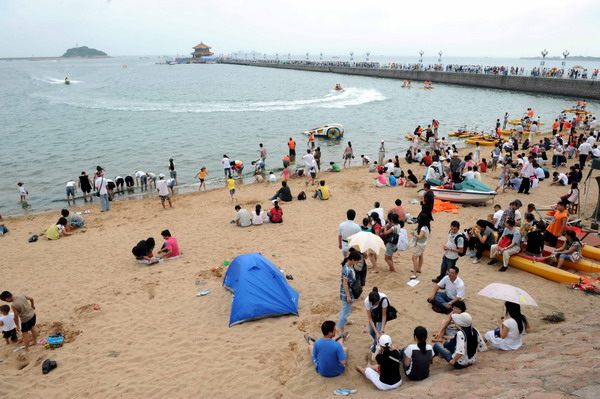8月5日傍晚開始,很多市民的朋友圈被這樣一則信息刷屏:當天下午3時許,跟隨媽媽從北京來青島旅游的8歲雙胞胎姐妹裴元槿和裴元桐在青島西海岸新區萬達公館南側沙灘玩耍時失聯。當晚,青島西海岸新區組織公安、邊防、山海情救援聯盟的隊員們在沙灘、酒店和相關海域展開徹夜搜救,不少熱心市民也加入。昨天上午,救援人員在離岸50多米遠的海里先后發現了姐妹倆。令人痛心的是,她們緊閉的雙眼,已經永遠無法再睜開。
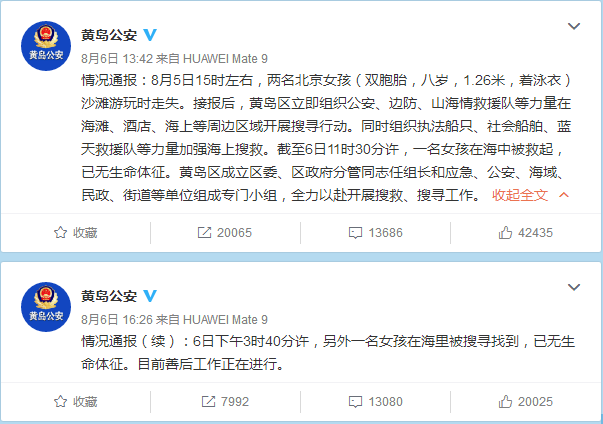
關于溺水女孩的報道及一些溺水知識雙語:
Police in Qingdao, Shandong province, confirmed on Monday that 8-year-old twin girls who traveled from Beijing had been found drowned.
山東青島警方8月6日確認,在青島旅游的北京8歲雙胞胎姐妹溺水身亡。
The twins - Pei Yuanjin and Pei Yuantong, according to reports - had come to the coastal city with their mother for a holiday.
據報道,這對雙胞胎姐妹裴元瑾、裴元桐與母親一起到海濱城市青島度假。
A rescue team found the body of the elder twin around 11:30 am and the other at 3:45 pm in waters near the place the girls were reported missing.
8月6日上午11:30,搜救隊在通報的失蹤地點附近水域發現了姐姐的尸體,下午3:45發現了妹妹的尸體。
The twins' deaths drew wide concern on social media, with many comments warning of possible dangers. Some social media users, who seemed familiar with tidal currents in Qingdao, said the sea often ebbs at the time the twins vanished, and people can be carried off easily by the current.
這對雙胞胎溺水身亡的消息在社交媒體上引起廣泛關注,許多評論留言都提醒要留意潛在危險。一些似乎非常熟悉青島海潮的網友說,這對雙胞胎失蹤期間正值海水退潮期,水流很容易將人卷走。
Drowning cases are known to increase in the summer months, especially in rural regions where rivers and pools are unpatrolled and children are often allowed to play unattended.
夏季是溺水事件的高發期,特別是在郊區,河流和池塘都疏于監管的地方,孩子們通常在無人照看的情況下玩水。
那么,遇到溺水時,應該如何自救或者救助他人?
Most of us think we know what drowning looks like. We’ve seen it on T.V. or in a movie. Right?
很多人都認為自己知道溺水是什么樣子。我們在電視或電影上都看到過。對吧?
Someone is wildly flailing their arms and crying for help. That is how we know someone is in trouble.
溺水的人拼命拍打水面,大聲呼救。這是我們的概念中所了解的溺水狀況。
But is that reality?
但事實真的如此嗎?
According to Dr. Frank Pia – over 20 years experience as a life guard – there is an instinctive drowning response that looks less like the movies and more like someone treading water. What are the signs of Instinctive Drowning Response?
據有20多年救生員從業經歷的Frank Pia博士介紹,人溺水時有一種本能的反應,這種反應不怎么像電影中演的那樣,而更像是在踩水。人本能的溺水反應有哪些表現?
Drowning is a silent killer. Victims may not be able to call for help because they are expending all of their energy trying to breathe or keep their head above water. When water is inhaled, the upper airway or larynx (voice box) may go into a spasm, making it difficult to cry for help.
溺水是個無聲的殺手。溺水者往往無法呼救,因為他們要竭盡全力進行呼吸或將頭部露出水面。一旦吸入水,上呼吸道或喉頭可能會引發痙攣,很難發聲呼救。
Victims of drowning usually do not thrash in the water as often depicted on television or in the movies. Most victims are found floating or submerged in the water.
溺水者通常不像電視或電影中演的那樣拍打水面。大部分溺水者被發現時呈漂浮狀或沉入水中。
The signs of drowning
溺水的跡象
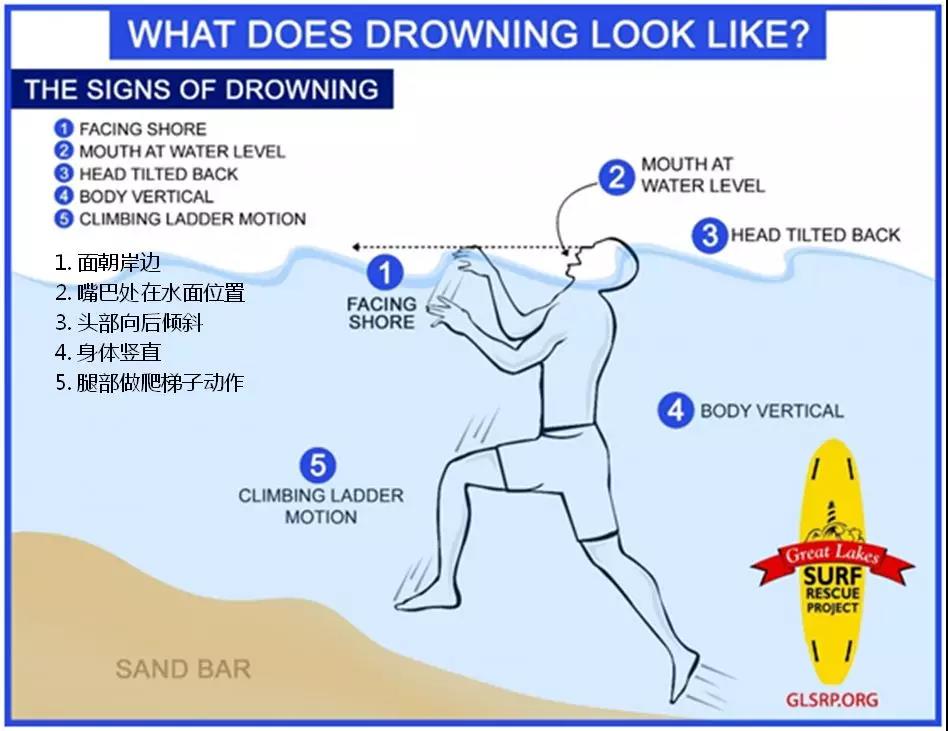
1. Except in rare circumstances, drowning people are physiologically unable to call out for help. The respiratory system was designed for breathing. Speech is the secondary or overlaid function. Breathing must be fulfilled before speech occurs.
除極少數情況外,溺水者從生理上幾乎無法呼救。呼吸系統的構造是為了呼吸空氣,講話是次要功能或附加功能。只有當呼吸條件滿足了,才能進行講話。
2. Drowning people’s mouths alternately sink below and reappear above the surface of the water. The mouths of drowning people are not above the surface of the water long enough for them to exhale, inhale, and call out for help. When the drowning people’s mouths are above the surface, they exhale and inhale quickly as their mouths start to sink below the surface of the water.
溺水者的嘴時而沒入水面,時而露出水面。他們的嘴無法長時間在水面保持呼吸,并大聲呼救。當他們的嘴露出水面時,必須盡快呼吸,因為接下來嘴巴就要沒入水面。
3. Drowning people cannot wave for help. Nature instinctively forces them to extend their arms laterally and press down on the water’s surface. Pressing down on the surface of the water permits drowning people to leverage their bodies so they can lift their mouths out of the water to breathe.
溺水者無法揮動胳膊求救。自然的身體反應本能地使他們向兩側張開手臂,將水面往下壓,這樣可以向上帶動身體,使嘴巴露出水面呼吸。
4. Physiologically, drowning people who are struggling on the surface of the water cannot stop drowning and perform voluntary movements such as waving for help, moving toward a rescuer, or reaching out for a piece of rescue equipment.
從生理上講,在水面掙扎的溺水者會不停嗆水,無法自主揮手呼救、向施救者移動或者伸手獲取救生設備。
5. From beginning to end of the Instinctive Drowning Response people’s bodies remain upright in the water, with no evidence of a supporting kick. Unless rescued by a trained lifeguard, these drowning people can only struggle on the surface of the water from 20 to 60 seconds before submersion occurs.
本能反應自始至終,溺水者的身體在水中一直處于直立狀態,無任何跡象表明需要施救。除非是經過訓練的救生員,否則溺水者只能在水面掙扎20-60秒,之后就會沒入水中。
Drowning Survival Strategy
溺水求生策略
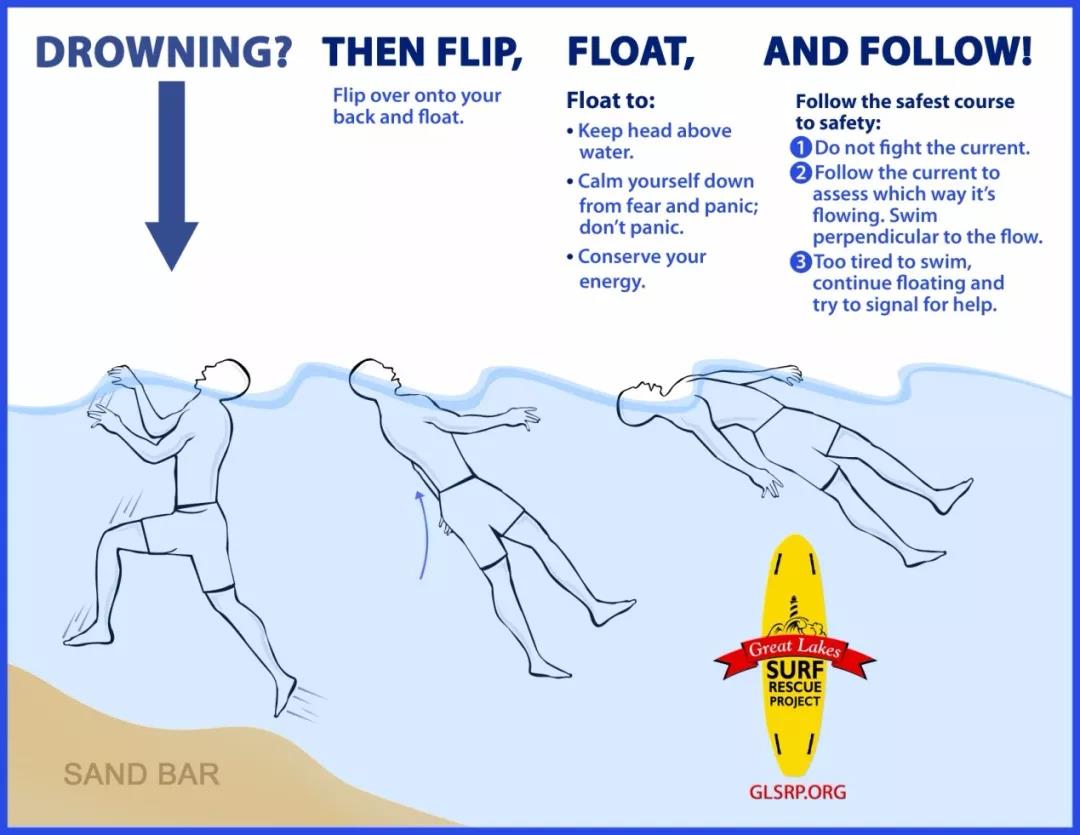
The Great Lakes Surf Rescue Project (GLSRP) announces its continued endorsement of the “Flip, Float, and Follow” Drowning Survival Strategy.
大湖區沖浪救援計劃一直推崇“翻、浮、從”的溺水求生策略。
“As long as you are floating, you are alive and buying time for rescue to arrive,” said David Benjamin, executive director.
該計劃執行理事大衛·本杰明說:“只要能浮在水上,你就能活下來,爭取時間等待救援。”
“And the old rip current survival strategy, ‘Don’t panic swim parallel to shore’, may not always work because longshore currents run parallel to shore and structural currents run parallel to the structures (piers and jetty walls). It’s best to assess which way the current is pulling you before your risk swimming against it.”
“傳統的離岸流求生策略讓人們‘不要慌張,與海岸保持平行游動’,但此舉并非屢試不爽,因為順岸流與海岸平行,結構流的方向與結構(如防坡堤)一致,最好判斷一下水流將你沖向何方,再決定是否冒險逆流而上。”
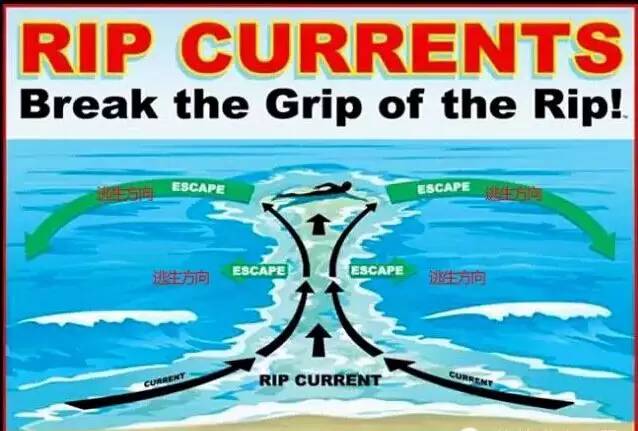
How to use the “Flip, Float, Follow” Drowning Survival Strategy – If you are ever caught in water over your head or a Dangerous Current:
如果你陷入沒過頭頂的水域或者危險的水流中,該如何使用“翻、浮、從”的溺水求生策略呢?
1. FLIP: “翻”
Flip over onto your back and float.
翻轉身體,背朝下浮起來。
2. FLOAT: “浮”
A. Float to keep your head above water.
通過漂浮保持頭部在水面之上。
B. Float to calm yourself down from the panic and fear of drowning.
通過漂浮讓自己從慌亂和溺水的恐懼中冷靜下來。
C. Float to conserve your energy.
通過漂浮保持體力。
3. FOLLOW: “從”
Follow the safest path to safety / out of the water.
隨從最安全的路徑脫離危險或離開水域。
A. Do not fight the current.
不要對抗水流。
B. Follow the current to assess which way it’s floating. Swim perpendicular to the flow.
跟從水流判斷流向,朝與水流垂直的方向游動。
C. Too tired to swim, continue floating and try to signal for help.
無力游泳時,保持漂浮狀態,設法發出求救信號。
REMEMBER:
切記:
As long as you are floating, you are alive.
只要浮在水面,你就能活下來。
As long as you are struggling or fighting a current, you are drowning – Conserve your energy and do not do the Signs of Drowning.
掙扎和逆流都會讓你溺水——保持體力,避免“溺水跡象”。
Dry Drowning vs. Wet Drowning
干性溺水和濕性溺水
According to the World Health Organization, drowning is defined as "...the process of experiencing respiratory impairment from submersion/immersion in liquid. "While there may be dry or wet, depending upon whether some water is inhaled into the lungs.
根據世界衛生組織,溺水是指“在浸沒/浸入液體中出現呼吸功能損害的過程” 。溺水又分為“干性溺水”和“濕性溺水”,取決于水是否被吸入肺部。
In the drowning sequence, laryngeal spasm occurs by water entering the upper airways. In most drowning cases, the spasm relaxes and water enters the lungs. Historically, this was known as a wet drowning. In 10% to 20% of drowning cases, the laryngeal spasm does not relax and no water enters. This was known as dry drowning. It is now felt that there is no clinical difference between wet and dry drowning and the distinction does not affect patient treatment or outcome.
溺水時,進入上呼吸道的水會引發喉部痙攣。多數情況下,痙攣會松弛,水會進入肺部,這就是所謂的“濕性溺水”。在10%-20%的溺水案例中,喉部痙攣無法松弛,沒有水進入肺部,這就是“干性溺水”。兩種溺水沒有臨床差異,二者的區別不影響患者治療。
However breathing problems can be delayed as few as 1 hour to 24 hours after leaving the water. It is important then to note the symptoms of dry drowning.
不過,離開水后,呼吸問題可能滯后1至24小時出現。所以,留意“干性溺水”的癥狀十分重要↓
Difficulty breathing or shortness of breath
呼吸困難或呼吸短促
Chest pain
胸痛
Extreme fatigue
極度疲勞
Some children have had loss of bowel or bladder control
一些孩子的腸道或膀胱失控
Persistent coughing
持續咳嗽
Change of mood
情緒變化
Fever
發熱
這些基礎的救援方法可以在關鍵時刻拯救生命,希望你和身邊的人都能掌握。
以下給出青島8所正規海水浴場,夏天下海還是需要去正規的海水浴場玩。
目前,青島市正規設立的海水浴場有第一海水浴場、第二海水浴場、第三海水浴場、第六海水浴場、石老人海水浴場、金沙灘海水浴場、銀沙灘海水浴場、靈山灣(城市陽臺)海水浴場等共8處。
青島市城市管理局提醒,其他所謂的“野浴場”,均為屬地管理的沙灘,并非海水浴場,沒有任何浴場的配套設施和救生救護人員及醫護保障人員,希望游客為了自身安全和家人,不要到這種所謂的浴場進行游泳。
第一海水浴場
一浴位于匯泉灣,始建于1899年。一浴沙平面廣,沒有暗礁隱壑和旋渦,很受市民及游客歡迎。高峰時,每天可接納25—30萬人入浴,最高時日接待量曾達35萬人次。
第二海水浴場
二浴位于匯泉灣東側的太平灣內,又稱“太平角海水浴場”,與八大關別墅區相鄰,建于1934年。二浴坡緩、沙軟、浪小、水凈,岸灘面積大,許多國家領導人及外國元首等,都曾在這里暢游過。
第三海水浴場
三浴位于太平角東側,建于1934年。三浴規模雖不大,但海水卻非常清澈。沙灘上建有一幢幢風格多樣的更衣室,更衣室沖浴的水是熱水,很適合不習慣冷水沖浴的人。因為風景很好,也是拍攝婚紗照的熱門取景地。
第六海水浴場
六浴位于太平路棧橋之西,毗鄰火車站,又稱“棧橋海水浴場”。許多從未見過大海的外地人,初識大海便是在這里。六浴的海岸線是青島最美的地方之一,浴場沙灘的沙子大部分是新換的,沙質細軟,尤其適合沙灘嬉戲。
石老人海水浴場
石老人海水浴場位于嶗山區海爾路南端,是青島市區最大的海水浴場之一。浴場左端海中17米高的石柱是基巖海岸典型的海蝕柱景觀,外形如老人坐在碧海之中,故稱“石老人”,是青島非常著名的景點。石老人海水浴場還被評為中國最美的日出地之一。

金沙灘海水浴場
金沙灘海水浴場在黃島金沙灘旅游度假區內,金沙灘是我國沙質最細、面積最大、風景最美的海水浴場之一,被稱為“亞洲第一灘”。
銀沙灘海水浴場
青島銀沙灘位于青島開發區鳳凰島旅游度假區西南側,與金沙灘為姊妹灘,全長2000余米,呈月牙形狀,東西伸展,水清灘平,是天然的海水浴場。
靈山灣海水浴場
位于西海岸新區城市陽臺,每年9月份都有拉網捕魚活動,游客量逐漸增多。今年開始,位于海水浴場西側的中央公園開始建設,占地近5000畝。
青島八大海水浴場位置及服務監督電話
第一海水浴場 青島匯泉灣 82963355
第二海水浴場 匯泉灣東側的太平灣內 66577309
第三海水浴場 太平角東側、湛山灣畔 66577319
第六海水浴場 東臨棧橋、西接海上皇宮、北靠太平路、南邊與小青島隔海相望 82868575
石老人海水浴場 東起藍色風帆雕塑西側入口處至石老人海水浴場東停車場正前 88894195
金沙灘海水浴場 開發區鳳凰島旅游度假區中部 86707399
銀沙灘海水浴場 鳳凰島國家級旅游度假區的西南部 89602009
靈山灣(城市陽臺)海水浴場 黃島區城市陽臺景區 83978302




